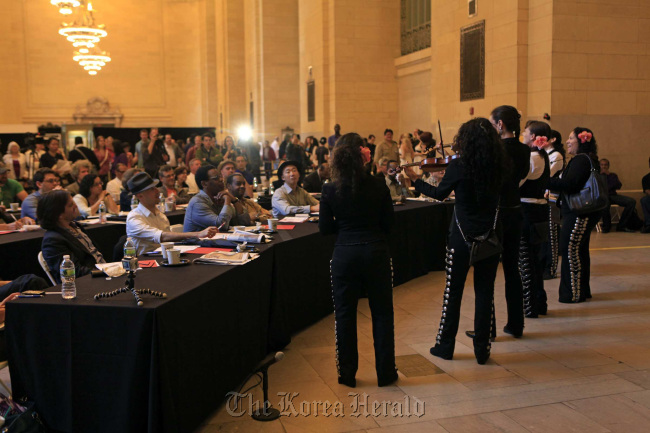
Members of Mariachi Flo de Toloache, an all-female group, audition for a panel of judges for Music Under New York at Grand Central Station in New York City on May 16, trying to get an official permit to play music in the city’s subway system. (MCT)
NEW YORK ― Luke Folger was in a mild state of panic. His one-man-band contraption had gone dead in front of three rows of judges, and time was ticking by. Folger knelt on the floor of Grand Central Terminal and rummaged through a jumble of cables and plugs, trying to figure out what was wrong.
A violinist-juggler act was waiting to take the stage. So were an urban-acid-jazz guitarist and a onetime “American Idol” contestant. Perhaps worst of all: Another one-man band was in the wings, his snare drum, cymbals, tambourine and horns all working as he warmed up behind a black curtain inside the famous transit station.
The acts were competing in one of the most unusual tryouts in the music world: the chance to snag prime performance space in the New York subway system, where playing in the bustling halls of Penn Station rather than a distant Brooklyn tunnel can mean the difference between big bucks and small change, an admiring audience and cranky commuters.
This was the 25th year for the auditions, which Music Under New York ― part of the city’s Metropolitan Transit Authority ―launched in a wider effort to take the edge off navigating the city’s dank underbelly, which swelters in the summer, freezes in the winter, and draws rats, roaches, pigeons and even an occasional opossum.
“For me, it’s about having a great ride,” Sandra Bloodworth, director of the Arts for Transit program, said as a bluegrass trio performed for 33 judges, ranging from singer-songwriters to subway workers, at the free tryouts last month.
Bloodworth admits that having harpists, rappers, violinists and accordion players performing in public transit systems might not work everywhere. But without them here, subway riders would have only squealing brakes, public service announcements crackling through squawk boxes, and the voices of squabbling couples or crying children to serenade them as they wait on grimy platforms for the next train.
“Close your eyes and imagine it all gone, and you have a sterile environment,” Bloodworth said of a world without buskers. “In New York, that’s not acceptable.”
Each year, about 70 acts audition to join the roster of performers who are guaranteed the right to occupy one of 25 sites considered best for public exposure ― places like the main corridor at Penn Station, or the upper-level mezzanine at Times Square, where on a busy weekend night a performer can make $200 in tips.
Those who don’t make the list may still perform, but they must cede the best spots whenever a rostered player shows up. They also can’t display the sign that identifies them as having scored one of the coveted spots.
By Tina Susman
(Los Angeles Times)
(MCT Information Services)


![[Herald Interview] 'Amid aging population, Korea to invite more young professionals from overseas'](http://res.heraldm.com/phpwas/restmb_idxmake.php?idx=645&simg=/content/image/2024/04/24/20240424050844_0.jpg&u=20240424200058)



